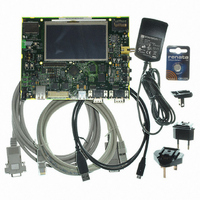AT91SAM9G45-EKES Atmel, AT91SAM9G45-EKES Datasheet - Page 979

AT91SAM9G45-EKES
Manufacturer Part Number
AT91SAM9G45-EKES
Description
KIT EVAL FOR AT91SAM9G45
Manufacturer
Atmel
Series
AT91SAM Smart ARMr
Type
MCUr
Datasheets
1.AT91SAM9G45-EKES.pdf
(56 pages)
2.AT91SAM9G45-EKES.pdf
(1218 pages)
3.AT91SAM9G45-EKES.pdf
(66 pages)
Specifications of AT91SAM9G45-EKES
Contents
Board
Processor To Be Evaluated
SAM9G45
Data Bus Width
32 bit
Interface Type
I2C, SPI, UART
Maximum Operating Temperature
+ 50 C
Minimum Operating Temperature
- 10 C
Operating Supply Voltage
1.8 V to 3.3 V
For Use With/related Products
AT91SAM9G45
Lead Free Status / RoHS Status
Lead free / RoHS Compliant
Other names
Q4626953
- Current page: 979 of 1218
- Download datasheet (19Mb)
41.4.2
41.4.3
41.4.3.1
41.4.3.2
6438F–ATARM–21-Jun-10
Memory Peripherals
Handshaking Interface
Software Handshaking
Chunk Transactions
Bus locking: Software can program a channel to maintain control of the AMBA bus by asserting
hmastlock for the duration of a DMAC transfer, buffer, or transaction (single or chunk). Channel
locking is asserted for the duration of bus locking at a minimum.
Figure 41-3 on page 977
eral. There is no handshaking interface with the DMAC, and therefore the memory peripheral
can never be a flow controller. Once the channel is enabled, the transfer proceeds immediately
without waiting for a transaction request. The alternative to not having a transaction-level hand-
shaking interface is to allow the DMAC to attempt AMBA transfers to the peripheral once the
channel is enabled. If the peripheral slave cannot accept these AMBA transfers, it inserts wait
states onto the bus until it is ready; it is not recommended that more than 16 wait states be
inserted onto the bus. By using the handshaking interface, the peripheral can signal to the
DMAC that it is ready to transmit/receive data, and then the DMAC can access the peripheral
without the peripheral inserting wait states onto the bus.
Handshaking interfaces are used at the transaction level to control the flow of single or chunk
transfers. The operation of the handshaking interface is different and depends on whether the
peripheral or the DMAC is the flow controller.
The peripheral uses the handshaking interface to indicate to the DMAC that it is ready to trans-
fer/accept data over the AMBA bus. A non-memory peripheral can request a DMAC transfer
through the DMAC using one of two handshaking interfaces:
Software selects between the hardware or software handshaking interface on a per-channel
basis. Software handshaking is accomplished through memory-mapped registers, while hard-
ware handshaking is accomplished using a dedicated handshaking interface.
When the slave peripheral requires the DMAC to perform a DMAC transaction, it communicates
this request by sending an interrupt to the CPU or interrupt controller.
The interrupt service routine then uses the software registers to initiate and control a DMAC
transaction. These software registers are used to implement the software handshaking
interface.
The SRC_H2SEL/DST_H2SEL bit in the DMAC_CFGx channel configuration register must be
set to zero to enable software handshaking.
When the peripheral is not the flow controller, then the last transaction register DMAC_LAST is
not used, and the values in these registers are ignored.
Writing a 1 to the DMAC_CREQ[2x] register starts a source chunk transaction request, where x
is the channel number. Writing a 1 to the DMAC_CREQ[2x+1] register starts a destination chunk
transfer request, where x is the channel number.
Upon completion of the chunk transaction, the hardware clears the DMAC_CREQ[2x] or
DMAC_CREQ[2x+1].
• Hardware handshaking
• Software handshaking
shows the DMAC transfer hierarchy of the DMAC for a memory periph-
AT91SAM9G45
979
Related parts for AT91SAM9G45-EKES
Image
Part Number
Description
Manufacturer
Datasheet
Request
R

Part Number:
Description:
MCU ARM9 64K SRAM 144-LFBGA
Manufacturer:
Atmel
Datasheet:

Part Number:
Description:
IC ARM7 MCU FLASH 256K 100LQFP
Manufacturer:
Atmel
Datasheet:

Part Number:
Description:
IC ARM9 MPU 217-LFBGA
Manufacturer:
Atmel
Datasheet:

Part Number:
Description:
MCU ARM9 ULTRA LOW PWR 217-LFBGA
Manufacturer:
Atmel
Datasheet:

Part Number:
Description:
MCU ARM9 324-TFBGA
Manufacturer:
Atmel
Datasheet:

Part Number:
Description:
IC MCU ARM9 SAMPLING 217CBGA
Manufacturer:
Atmel
Datasheet:

Part Number:
Description:
IC ARM9 MCU 217-LFBGA
Manufacturer:
Atmel
Datasheet:

Part Number:
Description:
IC ARM9 MCU 208-PQFP
Manufacturer:
Atmel
Datasheet:

Part Number:
Description:
MCU ARM 512K HS FLASH 100-LQFP
Manufacturer:
Atmel
Datasheet:

Part Number:
Description:
MCU ARM 512K HS FLASH 100-TFBGA
Manufacturer:
Atmel
Datasheet:

Part Number:
Description:
IC ARM9 MCU 200 MHZ 324-TFBGA
Manufacturer:
Atmel
Datasheet:

Part Number:
Description:
IC ARM MCU 16BIT 128K 256BGA
Manufacturer:
Atmel
Datasheet:

Part Number:
Description:
IC ARM7 MCU 32BIT 128K 64LQFP
Manufacturer:
Atmel
Datasheet:

Part Number:
Description:
IC ARM7 MCU FLASH 256K 128-LQFP
Manufacturer:
Atmel
Datasheet:

Part Number:
Description:
IC ARM7 MCU FLASH 512K 128-LQFP
Manufacturer:
Atmel
Datasheet:










